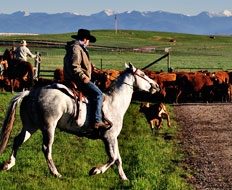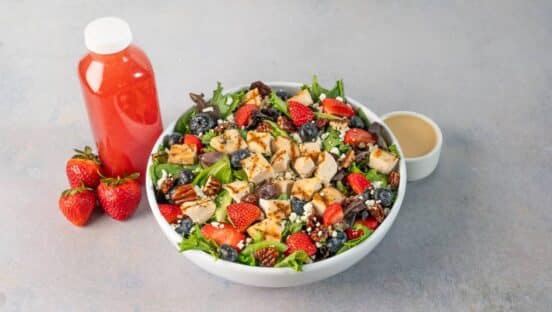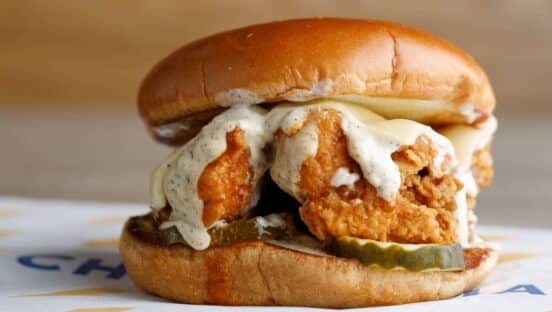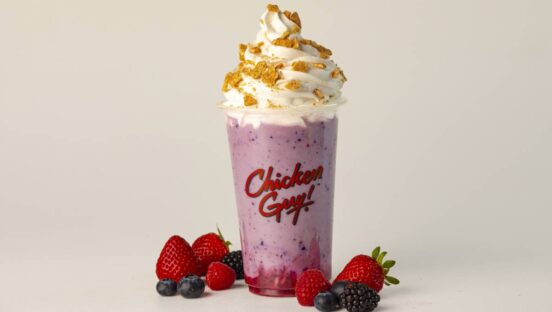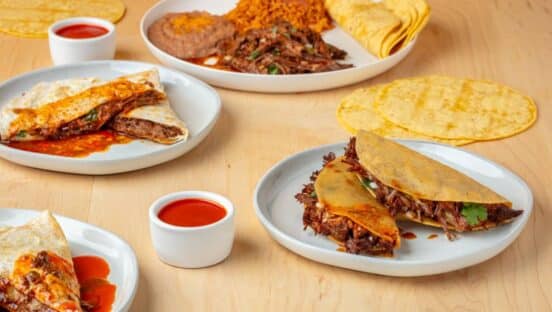Miles removed from the nearest highway, shopping mall, and chain restaurant—or any restaurant at all—lie 40,000 acres of forest, meadows, and pastures, home to wildlife of all sorts and 1,400 head of Red Angus cattle. The herd, property of Meyer Company Ranch, roam free under the big sky of Montana, munching on grass and mineral supplements, moving leisurely from one field to the next to avoid over-grazing. Rounded up by real-life cowboys just one day a year for vaccines—not antibiotics, not hormones—the cattle have little reason to stress.
The land the cattle live on is given the utmost care and attention, with water sourced from a 40-acre reservoir that collects runoff from streams, snow, and rainfall to irrigate the forest, meadows, and farmland and sustain wildlife and crops. Nine thousand acres of forest—which provide shelter to the elk, bears, and mountain lions that call the ranch their home throughout the year—are protected from infestations of pine beetles and bug worms, while self-sustaining fields of alfalfa, barley, and winter wheat, planted by the cowboys and ranchers themselves, help supply year-round feed for the cattle.
Even on the one bad day of their lives (as Meyer corporate chef John Enright likes to call the day the Red Angus are shipped off to slaughter), measures are taken to guarantee the cattle are as calm as possible; they’re handled gently and aren’t transported for more than 24 hours at a time.
The result: a “naturally raised and handled” beef product that has received a Certified Humane distinction, the American Heart Association’s Heart Check designation, and the American Culinary Federation’s seal of approval.
Meyer Company Ranch—housed under Meyer Natural Foods umbrella, owner of beef brands like Meyer Natural Angus, Laura’s Lean Beef, and Dakota Beef—is just one of the many operations in the U.S. that raises cattle in a different fashion than the industrial beef production of yesteryear. It’s also proof that not only is the face of the beef industry shifting, but so, too, is the type of beef customers say they want to consume and feed to their families.
Despite rising costs and increasing supply pressures, the evolution of and interest in the beef industry illustrates that customer demand for beef is far from scarce.
“I cannot ever envision that beef is not a preferred center-of-plate experience for the consumers out there,” says Richard Gebhart, an Oklahoma rancher and the National Cattleman’s Beef Association (NCBA) federation division chairman.
“The surveys we have say Americans like beef, they enjoy it, it’s something that people take pride in serving,” he adds. “I just don’t see beef going away.”
As of 2012, the average U.S. consumer ate 52 pounds of beef per year, according to the U.S. Department of Agriculture (USDA), second in demand only to poultry. Though there has been a continual decline since consumption peaked in the 1970s, desire for beef is significant, with seemingly no end in sight.
“Even in an environment of rising prices, the demand continues to be strong and operators are finding ways to keep it on their menu,” says Trevor Amen, director of market intelligence for NCBA, an advocacy group for U.S. beef producers. “That in turn keeps the customers coming through their door.”
But as consumers grow more sophisticated and increasingly express the desire to know what they’re eating and where it’s coming from, there seems to be a widening circle of beef eaters turning to products that are all-natural, sustainable, and hormone- and antibiotic-free, much like the product in which Meyer specializes.
“The education of the next generation coming up and the knowledge that they desire is huge,” Meyer’s Enright says. “They need to have more information in their hands, and that falls down to where the animals are being raised and developed, in addition to [having] no hormones and no antibiotics.”
Better-burger chain Shake Shack is known around the industry and by consumers for serving all-natural beef raised without hormones and antibiotics. Director of purchasing Jeff Amoscato says the beef fits the brand’s “stand for something good” mentality.
“That’s doing the better thing for our food and our supply chain and sustainability,” he says.
Some experts say consumers’ desire for better-for-you, better-for-the-environment beef is fueled largely by the growing health movement, which is gaining steam with lower-calorie products, gluten-free items, and, now, food that’s naturally and sustainably raised.
“If you take a broad view of what healthy means or even use the word wholesome, it all sort of plays in together,” says Chris Anderson, director of marketing for Meyer Natural Foods. “For some, it’s about calories, it’s about sodium levels in foods, and things like that; but for others, it’s about, Was this animal raised in a natural way? Are there preservatives in this food? Is it adulterated? Is it pumped with solutions? People generally are trying to be more conscientious about how they choose their foods.”
Enright says the growing availability of natural beef products on the market—especially in establishments like gourmet and better-burger restaurants—is putting pressure on restaurants that don’t serve this type of protein. “They’re seeing a decline in sales volume because the consumer is in a position to make that choice,” he says. “They’re not just locked into one thing right now.”
With all the attention the segment has seen in recent years, Anderson says, he wouldn’t be surprised if natural, antibiotic-, and hormone-free beef products go from making up roughly 3 percent of total U.S. beef production today to a number as large as 10 percent in the near future—a lofty but realistic projection that may encourage additional brands and producers to join the movement.
But the NCBA’s Gebhart says consumers, media, and even experts inside the industry have failed to realize or acknowledge the changes that have been made on the “conventional,” mass-production side of the beef industry, as far as sustainability and animal handling and welfare go—changes that bring these products closer in line with what the all-natural and sustainable producers are selling.
A few years ago, the Beef Checkoff program—a producer-funded marketing and research program designed to increase consumer demand for beef—put together a Cattlemen’s Stewardship Review (CSR) highlighting the efforts, evolution, and advancements that have been made within the beef industry. The review not only laid out the “Cattlemen’s Statement of Principles”—including such values as preserving the environment, protecting livestock, providing quality food for consumers, and enhancing food safety—but it also found that each pound of beef produced conventionally uses 20 percent less feed, 30 percent less land, 14 percent less water, and 9 percent less fossil fuel energy today than it did in 1977.
[pagebreak]
Cattlemen are also placing increased emphasis on perfecting practices and processes that guarantee cattle are as healthy and well maintained as possible, for their own sake as much as for the animals and consumers.
“Humanely raised beef contributes to the bottom line of producers,” Gebhart says. “The less stress on an animal, the more efficient that animal is in converting its input into something the consumer can use. So I don’t think good animal handling techniques add cost; they save costs for producers.”
That’s why some on the conventional side of the business say that, despite consumers believing they want all-natural beef, the marketing terms sustainable and humanely raised are coming to mean less both in reality and to consumers.
“It’s important to recognize that the word sustainability or sustainable is not an attribute of a product, but it’s a process and it’s about efficiency,” Gebhart says. “We’ve got a rich tradition of [efficiency]. The beef industry is not setting on its laurels. We’re becoming more and more efficient every day.”
Don Berchtold, chief operations officer of burger brand Fatburger, says “natural” and “sustainable” designations don’t register with the brand’s customers. “You look at how many brands now have different ways they’re marketing their product, whether it’s all-natural, whether it’s grass-fed, whether it’s grain-fed,” he says. “That’s for the customer to choose what their taste profile is, and … that’s what a brand is built on, a taste profile. That’s what attracts a customer to that brand in the end. It’s the product, and it’s the quality.”
Whether hormone- and antibiotic-free or not, the problem in the beef industry may not be a lack of customer demand or efforts toward sustainability. Instead, the difficulties mostly lie in tight supply and rising prices. Thanks to 2012’s severe drought that ravaged many beef-producing areas in the U.S., sky-high feed and input costs forced many farmers and ranchers to cull herds in order to stay afloat financially. And the trend has continued in 2013. Jim Robb, director of the Livestock Marketing Information Center, says the beef cowherd was down in the first half of the year and will likely continue to drop through the remainder of 2013. The industry, he says, could experience a 13 percent decline this year in terms of production of beef like that used to make burgers.
The latest numbers from the USDA’s Livestock, Dairy, and Poultry Outlook for June 2013 expect nearly 26 billion pounds of beef to be produced in 2013, down from 26.2 billion in 2012 but more than next year’s estimate of less than 25.5 billion.
Because the life cycle of a beef cow is rather lengthy—it can take up to two years to raise cattle to the point at which they’re ready for slaughter—more ranchers are selling off cows or sending them to slaughter early to survive financial hardships. Robb says this means the beef supply will likely not tick upward until 2016.
Shake Shack’s Amoscato says restaurants, even those in the limited-service industry, may be forced to cut portion sizes and focus on a “less is more” mindset in which the emphasis is placed on “getting a better product, not a bigger product.”
Smaller supply and expensive feed mean beef prices, both for brands and consumers, will likely continue to rise. According to the USDA’s Consumer Price Index, prices for purchases of food away from home are expected to grow by 2.5–3.5 percent this year, while beef prices will grow an estimated 3–4 percent.
“I think that with the price of inputs, specifically corn, we’ve hit a new level of pricing on beef,” Gebhart says.
This is forcing many quick-service brands to take a look at the supply chain and determine how to cope with these price increases. Because Fatburger buys a fresh beef product, Berchtold says, the brand can’t hedge the markets based on price.
“We have to have the consistency in the product, so we’re not a brand that goes out on the spot market and buys just anything,” he says. “We buy a specific trim type of beef, so we have to really stay abreast of the marketplace and look ahead.”
Though the concept is doing everything it can to cut costs down the supply chain, including cutting unnecessary utility costs and training employees to upsell when engaging with customers at the counter, Berchtold says the brand has been forced to make minor adjustments to prices and strategically create limited-time offers.
No customer welcomes a price increase, Berchtold says, but it certainly beats a drop in product quality. “Core customers understand it,” he says, “and core customers can tell when the product changes.”
To stay ahead of the market, Shake Shack works with its suppliers and ranchers to secure its beef supply 18–24 months ahead of time. Even with these precautions, though, the brand is concerned about rising beef prices.
“At every conference or meeting that I go to, nobody ever has any good news right now about beef prices coming down,” Amoscato says. “And because we’re so tied to one protein, when that continues to go up, we don’t really have relief elsewhere.”
While the brand considers developing alternative proteins in the future, Amoscato says, beef is and will continue to be the focus on the menuboard. “We’re the Shack Burger, we’re all-natural beef,” he says. “We’re not going to just go add a salad to the menu to help offset beef [prices].”
Amoscato says Shake Shack introduced a small price increase to its menu in January, and has taken a look at operational efficiencies to ensure it doesn’t have excessive waste in the restaurant. The chain is also working with suppliers to guarantee that all product is of the highest quality in order to get 100 percent utilization.
Though a burden, rising beef prices do have one advantage for Shake Shack and other brands like it. “For the consumer, as beef prices have gotten higher and higher, that gap between the conventional and all-natural [beef] has kind of come closer together,” Amoscato says. “So now you’re spending a lot of money on beef. It doesn’t matter what kind it is at this point. You’re going to demand a higher-quality product if you’re going to go spend the money on beef.”
He says consumers also enjoy feeling as if they’re contributing to the sustainability movement—at a low cost, at least. “They’re able to be part of that natural, no-hormone product without having to pay 10 times as much.”
Regardless, the pricing situation has many brands, especially those that specialize in beef as a protein, worried that customers may not visit quite as often or choose to visit concepts with a focus on alternative proteins. Gebhart says he’s spoken with everyone from independent restaurants to big chains like McDonald’s, “and they’re all concerned about the substitute effect on consumers turning from beef and going to something else.”
But supply and pricing aren’t the only problems the beef industry has in store moving into the future. To keep consumer interest in beef as high as possible and to make customers feel better about the beef they’re consuming, the industry will feel pressured to find a way to tell and sell the story of beef, Robb says.
The good news, Gebhart says, is that consumers like to know that their food comes from family-operated farms and ranches, as is often the case in the beef industry. In fact, according to the Beef Checkoff’s CSR, 97 percent of beef cattle farms and ranches in the U.S. are family-run operations.
“It’s not the story of the pork and poultry industries in the world, or let alone the United States,” Robb says. “From a beef industry perspective, … they are the family farms. They are not Mr. Tyson. They are not Smithfield.”
Meyer’s Anderson says the industry has an obligation going forward to focus on educating consumers so they understand everything that goes into the production process. “It’s not about catchphrases. It’s not about certain claims versus others,” he says. “It’s really just an education process. I think the beef industry by and large should become more attuned to that and just have a better ear for it.”
And though brands like Shake Shack and producers like Meyer would like to see the entire restaurant industry shift toward chemical-free, natural beef in the future, it’s a move that must be made gradually.
“It really comes down to having all types of parties involved, because you have a whole carcass to use,” Amoscato says. “If a big player came in, like a McDonald’s, that just wanted a certain portion of the animal, that could really throw the industry out of whack right now, because you can’t just all of a sudden move a bunch of all-natural all over the place. It needs to be a gradual growth and kind of have a coordinated, but not necessarily organized, approach to it.”
Nonetheless, he says, Shake Shack would like to see brands across the board develop an even better burger—the best, perhaps, made using top-notch and more responsible practices—in the coming years.
“You’re getting a better supply chain of product coming in, so a better way of that cattle being raised, a shorter distance that the cattle has to travel, better utilization of the land,” he says, adding that the burger of the future would even go so far as to feature GMO-free buns and cheese from RGBH-free sources. “That would be the better burger for everybody, if we could all achieve that.”

